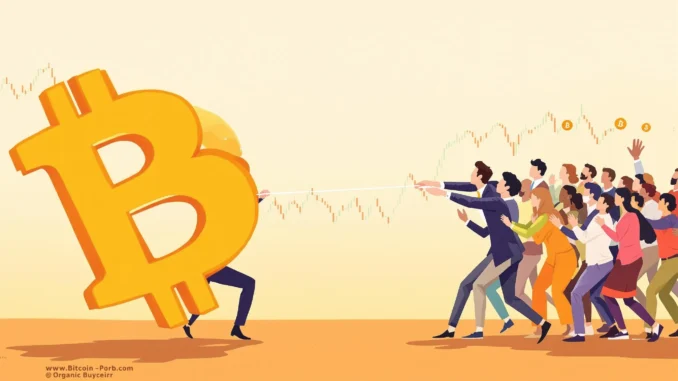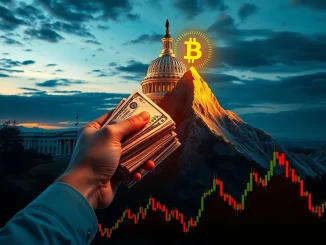
Bitcoin, the king of cryptocurrencies, has always been known for its thrilling price swings. But lately, the volatility feels less like organic market movements and more like a rollercoaster designed by Wall Street itself. According to crypto venture capitalist Kyle Chasse, we might be witnessing a classic liquidity game orchestrated by hedge funds, and the solution? A surge of ‘real organic buyers’ stepping into the arena.
Decoding Bitcoin Volatility: Are Hedge Funds the Culprits?
In a recent statement on X (formerly Twitter), Kyle Chasse, a prominent figure in the crypto VC world and founder of Master Ventures, shed light on the current market dynamics. He suggests that while the introduction of spot Bitcoin ETFs was hailed as a game-changer, attracting long-term investors, it inadvertently opened the door for hedge funds with a different agenda. But how exactly are these financial giants impacting Bitcoin’s price action?
Chasse argues that these hedge funds, unlike genuine crypto enthusiasts, “don’t care about Bitcoin” in its fundamental sense. Their primary interest lies in exploiting arbitrage opportunities. Let’s break down what this means:
- Arbitrage Explained: Arbitrage is a trading strategy that seeks to profit from tiny price differences of the same asset in different markets. In the crypto world, this often involves discrepancies between Bitcoin futures contracts (like those on the Chicago Mercantile Exchange – CME) and the spot price of Bitcoin.
- CME Futures Premium: CME Bitcoin futures often trade at a premium compared to the spot price. This is partly due to factors like institutional demand and the cost of holding futures contracts.
- Hedge Fund Strategy: Hedge funds are capitalizing on this premium by engaging in what’s known as a ‘basis trade’. They simultaneously buy Bitcoin in the spot market and sell Bitcoin futures contracts on the CME.
- Low-Risk Yield Trade: This strategy is considered low-risk because the price difference between spot and futures is expected to converge as the futures contract approaches expiration. The hedge fund essentially locks in a small, but relatively safe, yield.
- Impact on Volatility: While individually these trades might seem small, the collective action of numerous hedge funds engaging in arbitrage can amplify market volatility. Their actions are driven by short-term gains, not long-term belief in Bitcoin, potentially leading to sell-offs that contribute to price drops.
| Market Participant | Motivation | Impact on Bitcoin Price |
|---|---|---|
| Organic Buyers (Retail & Long-Term Investors) | Belief in Bitcoin’s long-term value, adoption, and potential. | Price stabilization, support during dips, long-term growth potential. |
| Hedge Funds (Arbitrage Traders) | Short-term profit from price discrepancies between spot and futures markets. | Increased volatility, potential for price swings due to rapid entry and exit based on arbitrage opportunities. |
The Urgent Need for ‘Real Organic Buyers’ in the Bitcoin Market
If hedge funds are indeed contributing to the current Bitcoin volatility through arbitrage strategies, what’s the antidote? According to Chasse, it’s the influx of “real organic buyers.” But who are these organic buyers, and why are they so crucial for market health?
- Defining Organic Buyers: Organic buyers are individuals and institutions who are investing in Bitcoin based on a fundamental belief in its technology, long-term value proposition, and potential for disruption. They are not primarily driven by short-term trading opportunities or arbitrage.
- Long-Term Perspective: Unlike hedge funds focused on quick gains, organic buyers typically have a longer investment horizon. They are more likely to HODL (hold on for dear life) through market fluctuations, reducing selling pressure during downturns.
- True Demand Signal: Organic buying represents genuine demand for Bitcoin as an asset. This demand is rooted in factors like decentralization, scarcity, and its potential as a store of value or medium of exchange.
- Counteracting Hedge Fund Influence: A strong base of organic buyers can act as a counterforce to the volatility introduced by short-term traders like hedge funds. Their consistent buying pressure can help stabilize prices and create a more robust market.
- Healthy Market Growth: A market dominated by organic demand is generally considered healthier and more sustainable in the long run. It reflects genuine adoption and belief in the asset’s fundamentals, rather than speculative trading activity.
Crypto ETFs: A Double-Edged Sword?
The approval of spot Bitcoin ETFs was a landmark moment for the crypto industry. It provided easier access for institutional investors and broadened Bitcoin’s appeal. However, as Chasse points out, it’s not without its complexities. While ETFs have attracted long-term holders, they have also inadvertently become a vehicle for hedge funds to engage in arbitrage, contributing to the current market turbulence.
Are crypto ETFs ultimately beneficial or detrimental? It’s likely a nuanced situation. ETFs can bring much-needed liquidity and institutional capital into the Bitcoin market. But, it’s crucial to be aware of the potential side effects, such as increased influence from short-term trading strategies that can amplify volatility. The key takeaway is that the market needs a healthy balance – ETFs can be a positive force when coupled with strong organic demand.
Actionable Insights: Navigating Bitcoin’s Volatile Waters
So, what does this mean for you, the crypto enthusiast or potential investor? Here are some actionable insights to consider:
- Understand Market Dynamics: Be aware that Bitcoin’s price is influenced by various factors, including both long-term holders and short-term traders like hedge funds. Recognizing these dynamics can help you make more informed investment decisions.
- Focus on Fundamentals: If you’re a long-term believer in Bitcoin, focus on its fundamental strengths – its technology, network effects, and adoption rate. Short-term price fluctuations are less concerning if your conviction is rooted in the long-term potential.
- Dollar-Cost Averaging (DCA): Consider using a dollar-cost averaging strategy to mitigate the impact of volatility. By investing a fixed amount at regular intervals, you can average out your entry price and reduce the risk of buying high.
- Stay Informed: Keep yourself updated on market trends and expert opinions. Following analysts like Kyle Chasse can provide valuable insights into the forces shaping the crypto market.
- Be Patient and HODL: If you believe in Bitcoin’s long-term value, patience is key. Market cycles are a natural part of crypto, and weathering the storms can be rewarding in the long run.
The Future of Bitcoin: Organic Growth vs. Institutional Games
The narrative around Bitcoin is constantly evolving. From its early days as a fringe digital currency to its current status as a mainstream asset class attracting institutional interest, Bitcoin’s journey has been anything but predictable. The current situation highlights a critical juncture: will Bitcoin’s price be primarily driven by genuine organic adoption and long-term investment, or will it become increasingly susceptible to the strategies of large financial players like hedge funds?
The answer likely lies in a combination of both. Institutional participation is essential for market maturity and liquidity. However, a healthy and sustainable Bitcoin market requires a strong foundation of organic buyers who believe in its long-term vision. As the crypto space continues to evolve, fostering organic growth and educating new users about Bitcoin’s value proposition will be crucial in ensuring its resilience and long-term success. The call for ‘real organic buyers’ is not just a market commentary; it’s a call to action for the crypto community to strengthen the foundations of the Bitcoin revolution.



